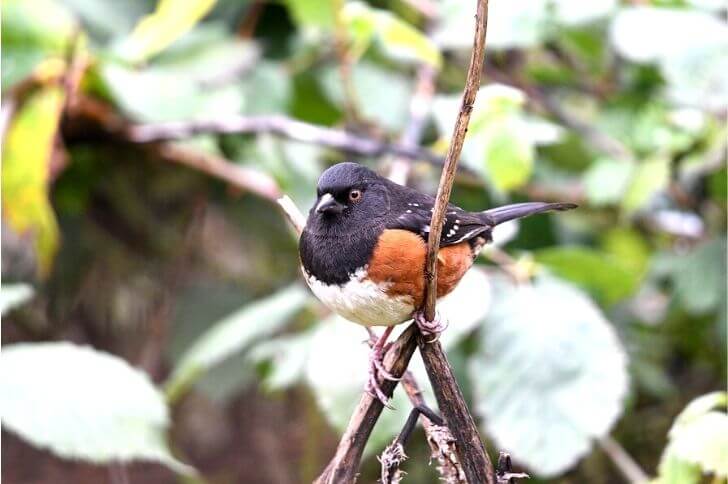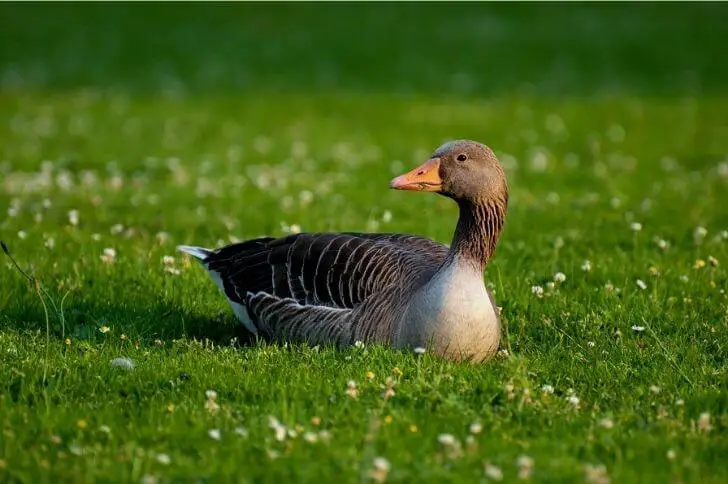Since the dawn of time, people have been fascinated by the unusual. Whether it is a black bird with black beak or a blackbird with white wings, something about these creatures just captivates us.
In recent years, there has been a resurgence of interest in black birds with white stripes or spots on their wings. Many believe that they are a sign from heaven, of good luck. Below we’ll explore some common birds. From the North America downy woodpecker to the Australian magpie, there is plenty to learn from this list.
List of Black Birds with White wings (Stripes & Spots)
1. Downy woodpecker

Size:
Downy woodpeckers are one of the smallest woodpecker species in North America. Measuring up to 6.5 inches (14 cm) and weighing under 1 oz (28g), this small bird is slightly larger than a house sparrow but smaller than the blue jay. Its wingspan is up to 11 inches or 30 cm.
Plumage:
How to identify the downy woodpecker. These small birds have a black back with white stripes down the sides. Note the white spots on the black wings. Males have a red cap while females have a black and white head.
Habitat & fun facts:
Downy woodpeckers live in deciduous and mixed forests, as well as open areas near trees. They eat insects, especially ants, and also berries and seeds. Downy woodpeckers nest in tree cavities or holes made by other animals.
Their calls include sharp “pik” notes and drumming sounds. To attract them to your backyard, put up some suet feeders.
2. Australian magpie

Size:
Australia is home to some of the most interesting birds in the world. The Australian magpie is a medium-sized songbird of the crow family, Corvidae. It is found throughout much of Australia, although it is not common in the driest areas.
The bird’s size ranges from 14 – 17 inches (37 – 43 cm), slightly smaller than the American crow, and weigh up to 12 oz. Australian magpie wingspan ranges from 25 – 34 inches.
Plumage:
With a black and white plumage and a long tail, the Australian magpie is easy to spot. The male and female are similar in appearance, although the male is slightly larger. Immature birds have less distinct plumage. The black wings have white patches near the shoulders which are visible during flight.
Habitat & fun facts:
This black bird with white on wings is omnivorous, feeding on insects, small reptiles, eggs, and carrion. It has a loud cawing call, which can be heard throughout much of Australia.
How long do magpies live for? According to research, magpies in Australia can live for 25 to 30 years in the wild. Each breeding season females lay a clutch of 3 – 5 eggs that hatch after about three weeks.
3. White winged chough
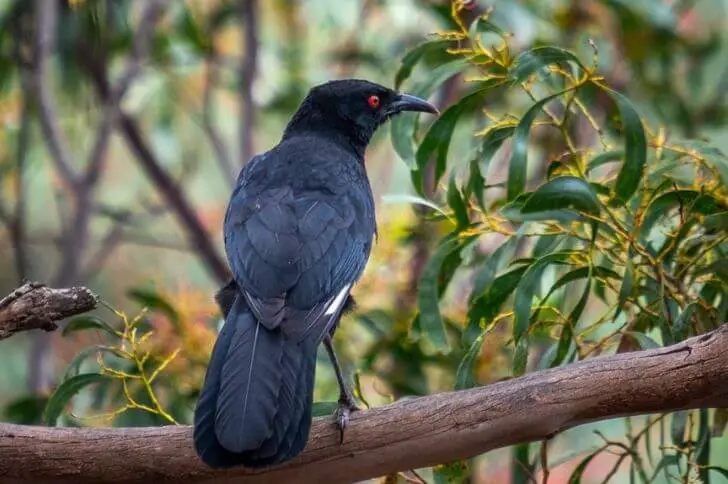
Source: leannen
Size:
When I first saw the white-winged chough I thought, ‘There is no way that black bird has white on its wing.’ Boy was I wrong. And I’ll tell you why. It’s almost the same size as the magpie above, 18 inches.
Plumage:
The white winged chough is characterized by its black body and bill, red eyes black wings and tail. Like I said, you’ll hardly see the white wing bars when the bird is on the ground. But when the bird is in flight, you’ll notice the patches on the wings.
Habitat & fun facts:
It is found mainly in Australia, where it feeds on beetles and termites. They’ll also eat fruit in the absence of insects. Breeding season starts from August through December. Females lay cream colored eggs and the males help incubate.
Why do white-winged choughs have red eyes? Like other birds with red eyes, white-winged chough have less melanin in their eyes, causing the blood vessels to be more visible.
4. Hairy Woodpecker
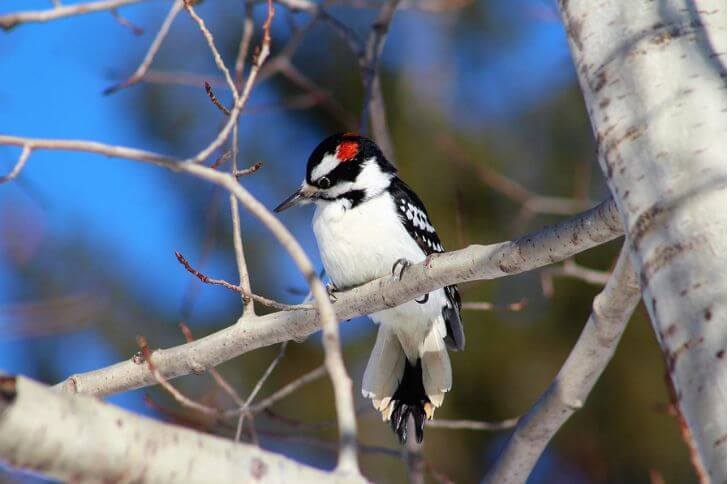
Size:
Measuring up to 10 inches, the hairy woodpecker is a North america black bird with spots on wings. It’s slightly larger than the downy woodpecker measuring up to 10 inches in length. It’s wings measure 16 inches when spread.
Plumage:
How can you tell a hairy woodpecker from a downy woodpecker? The birds are similar in plumage but the Hairy woodpecker is larger than the downy bird. Side by side, you’ll notice hairy woodpeckers are at least 3 inches larger.
Hairy woodpeckers are also black with white spots on wings. The red cap on head is less prominent compared to their cousin, the downy woodpecker.
Habitat & fun facts:
Their primary diet consists of insects, but they will also eat fruit and sap from trees. Hairy Woodpeckers live in open woodlands, parks, and gardens. They are cavity nesters and will use natural cavities in trees or abandoned birdhouses for nesting sites.
These birds are monogamous and the pair bond for life. The female lays 3 to 5 eggs and incubates them for 11 to 13 days. The young birds fledge at about 16 days old.
Related Read: Learn about other black birds
5. Black and white warbler
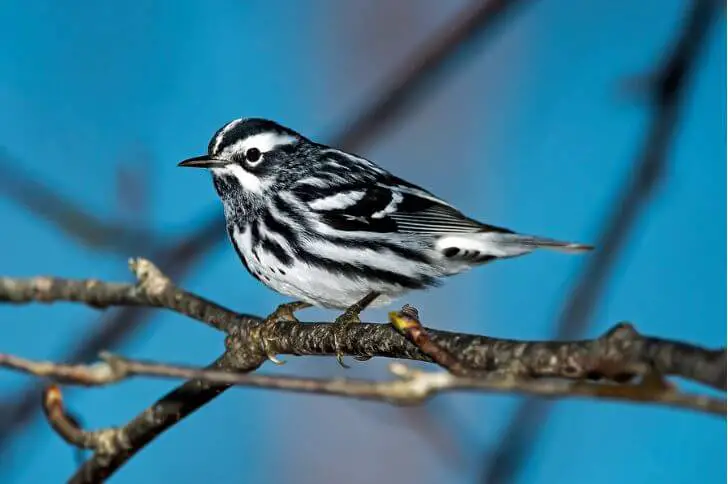
Size:
The black and white warbler is a small black and white bird that is about 4 inches long, same size as a house sparrow. They boast of a 8.7-inch wingspan and weigh up to 0.5 oz. Both sexes are the same size.
Plumage:
With black and white stripes, the black and white warbler is easy to spot. While bird watching, train your binoculars to their throats. Males have a black throats while adult females have white throats.
Habitat & fun facts:
They are usually found in open woodlands and meadows. Black and white warblers are migratory bird species. They spend the winter in Central America and Mexico and migrate to the United States and Canada in the spring. They breed in open areas with large trees, such as parks, forests, and meadows.
These birds eat spiders,and other small insects. They forage for food by hopping along the ground or climbing through trees and brush. Black and white warblers are very vocal birds and can be heard singing from early spring until late summer. Its sounds include ‘wee-see’ and ‘fsss’ notes.
6. White-winged widowbird

Size:
Measuring about 7 inches, the white-winged widowbird is a medium-sized bird found in open habitats in Africa south of the Sahara. It weighs about 0.8 oz and is sexually dimorphic.
Plumage:
The male is striking, with a black body, long fan-like tail and pale beak. Note the yellow and white panels on the wings. Females are much less conspicuous, being mainly pale brown and streaked.
Habitat & fun facts
White-winged widowbirds are highly territorial and unlike the birds we’ve looked at above they are polygynous. This means the male relates to three or four females during the breeding season.
Also, these black birds with white on wings are known for their aerial acrobats, spending much of their time flying high in the sky on lengthy courtship flights. White-winged widowbirds build large nests from sticks and grasses, which they line with softer materials such as feathers.
The diet of white-winged widowbirds consists mainly of seeds, which they glean from the ground or extract from plants with their long bills. They are also known to take insects on occasion.
7. Magpie lark

Size:
Another black and white Australian bird you should know about is the magpie lark. First described in the 1800’s, this bird species measures between 9 – 11 inches (25 – 30 cm) in length and can weigh up to 4 oz, same size and weight as the common blackbird.
Plumage:
Very distinctive. Found throughout Australia, this black and white bird is easy to spot. The head is mostly black with a white patch that stretches down its neck, black wings with white patches and a white belly. Take note of the white bill.
Habitat & fun facts:
This white winged black bird is found across the continent in open habitats including grasslands, savannas, woodlands and agricultural areas.
The song of the male magpie-lark is a series of high-pitched notes delivered in rapid succession, resembling the call of the European magpie.
8. Pied currawong

Size:
The pied currawong is a black bird with white stripes on wings and tail that is native to eastern and southeastern Australia. Both sexes measure between 17 – 20 inches (44 – 50 cm) with a wingspan of up to 30 inches. Male currawongs weigh up to 11 oz.
Plumage:
It is a medium-size black and white bird with a long tail. The sexes are similar in appearance, but the juveniles are browner and have less white on the wings and tail. Note its stunning yellow eyes.
Habitat & fun facts
The pied currawong is omnivorous, consuming a wide range of food. It is a gregarious species, forming large flocks outside the breeding season. It is considered a pest due to its habit of damaging fruit trees and competing with native birds for food. They have a loud “curra-wong” call. So, if you go bird watching in Australia, make sure to take some photos of these black bird with white stripes on their wings and tail.
9. White-winged black tyrant

Source: mattikyto
Size:
About 6 inches, big enough to fit in your palm. The white-winged black tyrant is a sparrow-sized bird that boasts a 9-inch wingspan. Sexes are almost the same size but have different colors.
Plumage:
The white-winged black tyrant (Myiobius leucopterus) is a passerine bird in the tyrant flycatcher family. It breeds in open woodland and scrub, mainly near water, across tropical South America from Colombia and Venezuela south to Paraguay and central Brazil. The nest is a shallow cup of sticks on a tree branch.
Habitat & fun facts
This common species is usually found in pairs or small groups, occasionally with mixed flocks of other Myiobius flycatchers. It forages for insects by making short sallies from an exposed perch. The call is a dry “tchik” or “tsip”.
10. White-winged tern
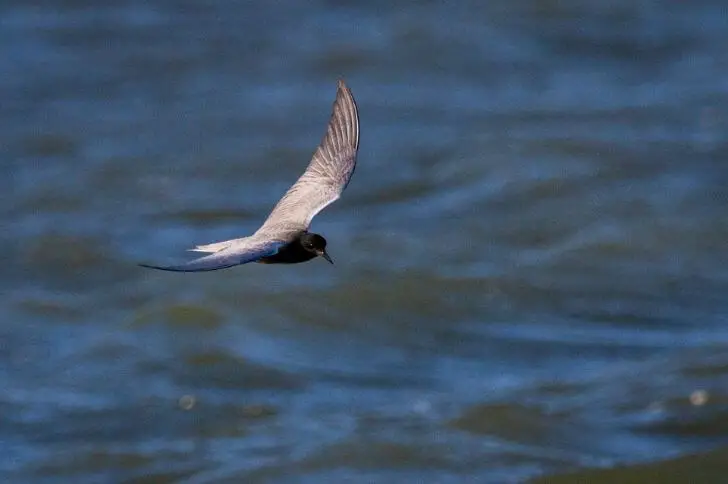
Size:
Measuring up to 10 inches, the white-winged tern is a small bird that weighs up to 2 oz. It is smaller than the common tern which measures up to 30 inches.
Plumage:
White-winged terns have a dark body, black head, and white wings. Both sexes are the same color. Young white-winged terns are mostly white with gray wings and pinkish feet.
Habitat & fun facts:
The white-winged tern is a seabird that can be found in coastal areas all over the world. These white winged black birds are very graceful in the air and are known for their aerial acrobatics. White-winged terns feed primarily on fish, but they will also eat crustaceans and other small aquatic creatures.
You’ll find these pairs in pairs and they typically mate for life. The female builds the nest and incubates the eggs, while the male provides food for her and the chicks.
11. White winged scoter
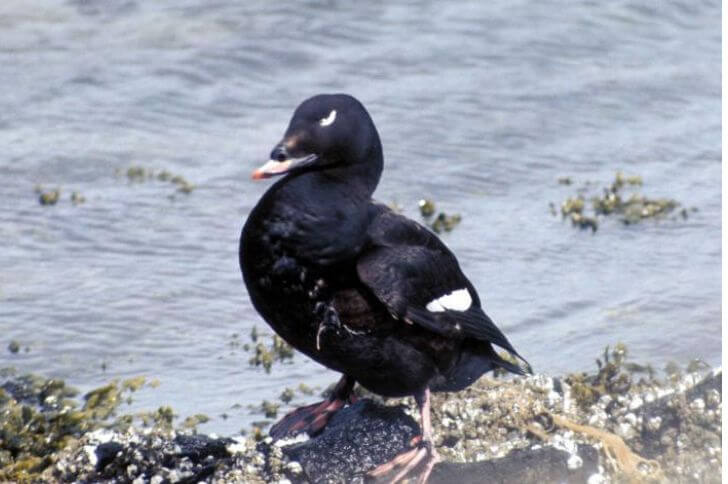
Size:
Looking for a large black bird with white on wings? Measuring up to 22 inches, the white-winged scoter is a large black and white waterbird that is common in parts of Western north america.
This large bird with white wing tips boasts of a 30-inch wingspan and can weigh up to 63 oz or 4 lbs. To put it in perspective, it is the same size as an adult common raven.
Plumage:
White-winged scoter birds are mostly black with white patches on their wings. Notice the orange-reddish bill and white eyes. Pretty hard to miss. Females are duller with a dark bill and black eyes.
Habitat & fun facts:
It is a member of the genus Melanitta which includes 5 other waterbirds. The genus name comes from Ancient Greek “melas” meaning “black” and “netta” meaning “duck”. Scoters commit to one partner and start breeding at 2 years.
Their incubation period lasts up to 30 days and young ones are left on their own after 3 weeks. These large black waterbirds prefer insects and crustaceans.
12. Black vulture

Size:
The black vulture is a large, black bird found in the United States and Mexico. It has a wingspan of up to six feet and a weight of up to six pounds. The black vulture species found in North America is heavier compared to vultures from other parts of the world.
Plumage:
The black vulture is easily recognized by its black glossy plumage and white wing tips which are visible when it’s on flight. Notice it’s dark grayish feet and short tail. It has brown eyes. Also, take note of easy to spot noses. This new world vulture is known for its keen sense of smell.
Habitat & fun facts:
These birds are scavengers, feeding on the carcasses of dead animals. They are known to be aggressive when competing for food, and have been known to attack humans. This large black bird with white wing tips is not considered threatened or endangered, but it is considered a nuisance because of its tendency to scavenge on livestock and carrion.
13. Common black hawk

Size:
The common black hawk is a black hawk with white wing tips. How big is a common black hawk? Size of the common black hawks varies from 17 – 21 inches (43 – 52 cm). Their wings are broad and they boast of a 46-inch wingspan which makes them one of the most powerful raptors in North america.
Plumage:
This large raptor has predominantly black plumage save for white wing linings which are visible when the bird is in flight. Also take note of the white bar on its tail. This large black bird with white wings and tail is unmistakable.
Habitat & fun facts:
The common black hawk is one of the most widespread species of black hawks and is also sometimes known as the white-winged black hawk. This raptor feeds on small to medium-sized prey, such as rodents, birds, reptiles and amphibians. It typically hunts from a perch, but can also perform aerial pursuit maneuvers to capture its quarry.
This raptor nests in trees, typically making a platform of sticks lined with leaves. The female common black hawk lays 2-4 eggs in a clutch, and both parents help to incubate and care for the young.
14. California condor

Size:
The California condor is a large black bird with white under wings. How big is the California condor? Males are slightly larger than female condors but overall these birds measure from 42.6 – 55 inches and can weigh up to 31 lbs. They also have powerful black and white wings measuring up to 9 feet.
Plumage:
The black condor has an all-black upper body. It has naked head with yellow patches. Notice its thick bill. When in flight you’ll notice the white feathers that stretch from the shoulders to near the tips.
Habitat & fun facts:
The California condor is an endangered species of bird that is found in the western United States. It was once common throughout the region, but populations declined dramatically due to hunting and habitat loss. Today, there are only around 500 California condors remaining in the wild.
These black birds rely on large open areas with plenty of tall trees for nesting and roosting. As development encroaches on these areas, the California condor’s habitat is shrinking. In addition, the birds are vulnerable to lead poisoning from eating carcasses that have been shot with lead ammunition.
Efforts are underway to save the California condor from extinction. Conservationists are working to protect key habitat areas and promote responsible hunting practices.
15. White-winged cotinga

Source: speciesaday
Size:
The white-winged cotinga or the Xipholena atropurpurea is a strikingly beautiful bird found that measures about 6 inches. They are almost the same size as the robin.
Plumage:
The male is mostly black, with striking white eyes and white wings. On the other hand the female has a slender body and is mainly gray with white wing tips. The most distinctive feature of this bird is its white wings, which can be seen when it takes flight.
Habitat & fun facts:
The white-winged cotinga is a shy bird that is not often seen by humans. It prefers to live in dense parts of the Amazon where it can find plenty of food and shelter. It feeds on fruit and insects. This bird nests in trees, laying two or three eggs at a time.
16. White-winged cliff chat

Source: jbrunsphoto
Size:
White-winged cliff chats are passerine birds that are found in the Afrotropics. These birds measure between 7 – 8.2 inches and weigh about 1.6 oz.
Plumage:
This chat is sexually dimorphic. Males spot a black back and head and a black upper breast. They also spot orange bellies. Females are all-black except for the white spot on the wings which you’ll also see on the males.
Habitat & fun facts
White-winged cliff chats are usually found in open areas near cliffs or other large rocks, where they can perch on exposed areas to watch for prey. This bird feeds primarily on insects.
17. Yellow-billed magpie
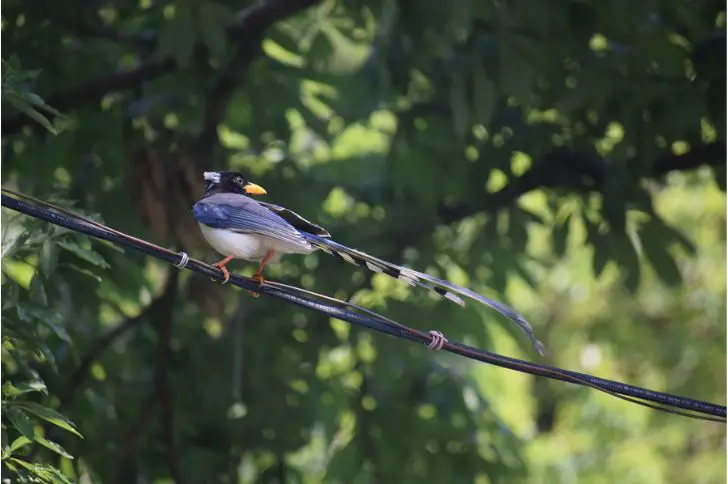
Size:
With 24-inch wingspan, yellow-billed magpies are medium-sized birds that can be found in western North America. Their bodies measure up to 21 inches (54 cm) and can weigh about 5 oz.
Plumage:
These black and white birds share the same colors, making it somewhat difficult to tell the sexes apart. They both have black head, breast, and back with white underparts. They also have a long slim tail and yellow bill. When in flight, you’ll notice the white stripes on their wings.
Habitat & fun facts:
What do yellow-billed magpies eat? These birds are omnivorous, feeding on a variety of items such as insects like grasshoppers, carrion and fruits. They are known for their intelligence and playful behavior, and often form social groups called “mischief or tribe.” Magpies are also known for their elaborate nests.
18. White-winged cuckooshrike
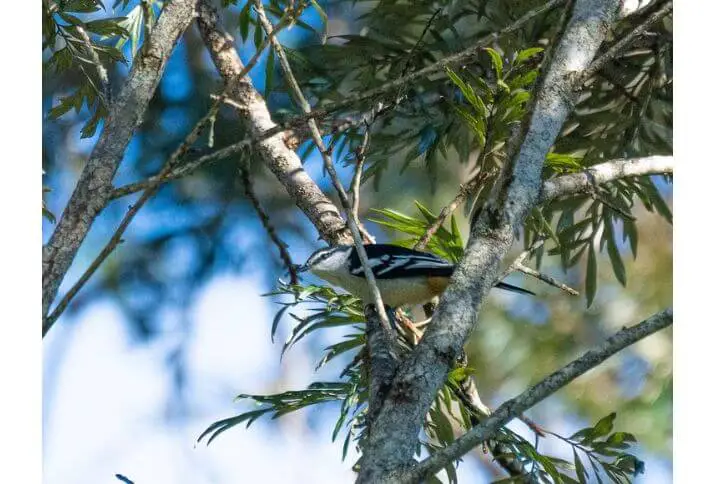
Source: geyseroptics
Size:
How big is the white-winged cuckooshrike? Endemic to the Philippines, this medium-sized bird ranges from 11 – 13 inches.
Plumage:
Also known as the white-winged cicadabird, the male has a dark rump, back and head with white on wings and tail tips. Female cuckooshrikes are mostly gray with palish underparts.
Habitat & fun facts
This blackbird feeds on insects and other small prey items, which it gleans from trees and bushes. It usually hunts by perching quietly and scanning the surrounding vegetation for prey, but it can also fly-catch or take prey from the ground.
This cuckooshrike bird species prefers moist lowland forests and is known to form flocks.
19. Lark Bunting

Source: lookaroundphotos
Size:
Common and gregarious, lark bunting are small black and white backyard birds that are easy to spot in Colorado. An adult lark bunting can measure up to 7 inches with a wingspan of 9 – 11 inches (25 – 28 cm).
Plumage:
Like most species in the passerillidae family they exhibit sexual dimorphism. Males are all black with large white patches on wings and tails. Females and immature birds are dark brown and heavily streaked.
Habitat & fun facts:
This small North American songbird is a migratory bird. It breeds in western North America, from Alberta Canada to California. The winter range extends from southern California to central Mexico. Lark buntings forage on the ground for seeds and insects. They are monogamous birds, and both parents help to care for the young.
20. Common loon

Size:
Scientifically known as Gavia immer, the common loon is a large water bird that can be found in North America and parts of Europe. How big are common loons? Adults measure between 26 to 35 inches with a weight of up to 13 pounds.
Plumage:
Common loons are easily identified by their black-and-white plumage, dagger-like bill, and red eye. Non-breeding birds are mostly grayish with black eyes.
Habitat & fun facts:
Loons are excellent swimmers and divers, and can stay submerged for up to 30 minutes. They are also known for their haunting call, which has been described as a laughing call. During breeding they are known for their loud yodels.
These black and white speckled birds inhabit both freshwater and marine environments, but they prefer cold, deep waters. They feed on a variety of prey items, including fish, amphibians, crustaceans, and insects. In the summer months, loons build nests on the ground near water and lay 1-3 eggs.
21. Blue-Throated Piping Guan

Size:
Blue-Throated Piping Guans are large turkey-like birds that are endangered due to hunting. An adult guan averages 3.5 lb in weight and 33 inches in length, making them one of the largest birds with white streaks on wings.
Plumage:
The adult has an all black body with white stripes on the long wings. The white color pattern stays hidden when the bird is patched.
Habitat & fun facts
Guans are social and are often seen in groups. These birds prefer feeding early in the morning or late in the evening and spend their afternoons resting. Their meal consists of fruit, seeds, and leaves. They are usually seen in pairs or small groups. The white-winged guan builds a platform nest of sticks high in a tree. 2-4 eggs are laid which are incubated for about 30 – 35 days.
22. Black Skimmer

Size:
The Black Skimmer is a unique bird found near the coasts of North and South America. Breeding adults are 15 – 19.7 inches (40 – 50 cm) in length with a wingspan of about 43 – 45 inches (109 – 115 cm).
Plumage:
They have a very distinct appearance, with a black cap, back and tail while the underparts are all white. They also spot bicolored beaks; orange and black-tipped. Black skimmers have short orange legs.
Habitat & fun facts
These birds are well-adapted to living near water, and can be seen skimming the surface for food. Black Skimmers typically eat fish, but they will also eat crustaceans.
They are social birds that live in colonies of up to several hundred individuals. They nest on the ground near water, laying 2-3 eggs at a time. The chicks are able to fly within two weeks of hatching, and will stay with their parents for several months after fledging.
Their calls are mostly nasal barks.
23. Rose-breasted Grosbeak
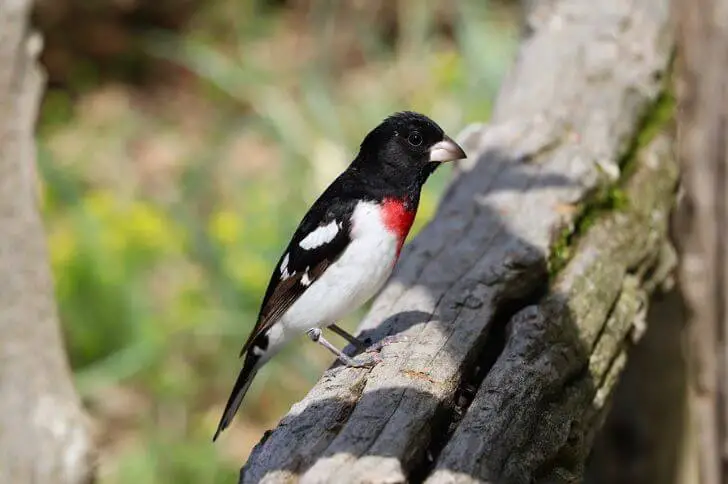
Size:
Measuring the same size as the spotted towhee, the rose-breasted grosbeak is a unique songbird of the New World. These black and white birds weight ranges from 1.0 to 1.7 oz and boast of a wingspan of up to 13 inches.
Plumage:
Males and females have different color patterns. Male are black and white; black back with white spots and white underparts with a red breast. Females are a heavily streaked brown with a gorgeous white eyebrow.
Habitat & fun facts
It breeds in eastern North America and in the boreal forest of Canada. This species is migratory, wintering in Central America. It is a very common bird, found in open woodlands, gardens, parks and farmland. The rose-breasted grosbeak eats seeds, berries and fruit.
Rose-breasted grosbeak calls include loud “chink” calls and harsh squawks.
24. Black-and-white hawk-eagle

Source: willianmenq
Size:
Spectacular and powerful, the black-and-white hawk-eagle is a rarely seen bird from Mexico. Both sexes are about the same size; 20 – 24 inches and weigh about 30 oz.
Plumage:
It has black plumage on its head, wings, and tail. The rest of its plumage is white. The bill and feet are yellow.
Habitat & fun facts:
The black-and-white hawk-eagle is a raptor found in forest and montane habitats. It is a member of the genus Spizaetus and family Accipitridae. This raptor feeds on a variety of prey, including birds, mammals, reptiles, and amphibians. It typically hunts from a perch in a tree or on a cliff edge.
Also read: Here are birds with white heads
25. Oriental magpie-robin

Size:
7.5 inches long including its tail and weighing up to 1.4 oz, the oriental magpie-robin is a medium size bird that most bird watching enthusiasts have spotted in parts of Asia.
Plumage:
They are black with a white belly and a long tail. Note the white wing bars on the black wings. They are named for their characteristic call, which sounds like a Magpie’s cry.
Habitat & fun facts:
This small passerine bird is found in cultivated areas and open woodland throughout much of Southeast Asia. They are usually seen in pairs or small groups, and are very territorial birds, defending their territory vigorously.
These birds are insectivores, and feed mainly on insects found on the ground. They are also known to take fruit from trees. They build a cup-shaped nest out of grasses and other materials, which they often place high in a tree. The female lays 3-4 eggs, which both parents help to incubate.
26. White-winged black tit
Size:
When in flight it is easy to mistake the white-winged black tit for the female white-winged cliff chat. Also known as the white-winged tit or the northern black tit, this bird is about 6 inches from head to tail.
Plumage:
This passerine bird has a black head, back and tail. The underparts are also black. Both sexes have white color pattern on their wings. The bill is black and the legs are dark gray. The sexes are similar in appearance, but juveniles are paler than adults.
Habitat & facts
The white-winged black tit is a very common bird and can be found in a variety of habitats, such as forests, gardens, and parks. These birds feed on insects and seeds. They build their nests in trees or bushes using twigs and grasses.
27. White-winged apalis

Source: Budgetbirders
Size:
With stunning color patterns, the white-winged apalis is a 6 inch bird that is common in parts of Africa.
Plumage:
Its color pattern includes a black head, back and tail, white throat, and yellow breast and belly. Note the long thin tail. The male also has red eyes. Females are gray and yellow.
Habitat & fun facts
It is a member of the cisticolidae family which includes other warbler birds. This species is usually seen alone or in pairs, foraging for insects or nectar from flowers. It builds a small cup nest from plant fibers which is suspended from a tree branch.
The white-winged apalis is found in open woodland, savannahs and gardens across much of sub-Saharan Africa.
28. Black Baza

Sources: photo.raptors
Size:
Medium sized around 11 inches to 14 inches. The black baza weighs 5.9 oz and has a wingspan that ranges 26 – 31 inches.
Plumage:
The baza is mostly black. It has a lightly barred white belly and features white wing patches which are visible when the wings are folded. Note the slender crest. The sexes are similar in appearance but the juveniles are browner with buff underparts.
Habitat & facts:
This bird of prey is a member of the family Accipitridae. It favors open woodland, forest edge, cultivated areas, and urban habitats. It is a resident breeder in parts of India, Sri Lanka, and Southeast Asia.
This species is a common and conspicuous bird in open country where it perches prominently on telephone wires or other high perches from which it sallies forth to hawk for insects. This white winged black bird is also known to scavenge at rubbish dumps.
29. Black guillemot
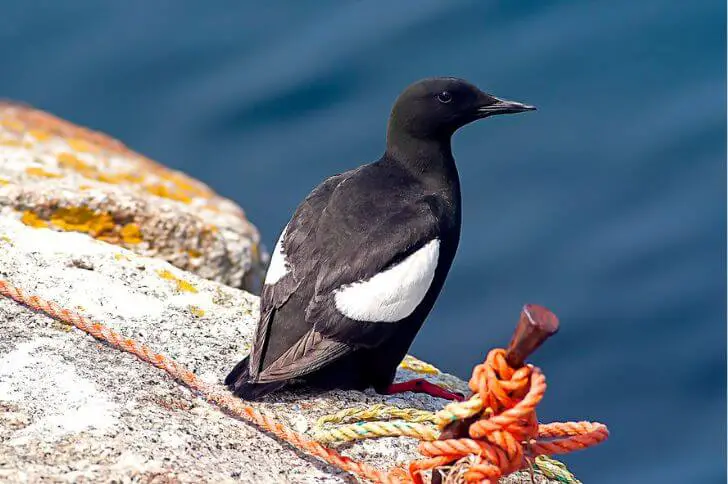
Size:
Measuring about 12 inches, the black guillemot bird is a medium-sized black and white seabird that is found in the cold waters of the North Atlantic and North Pacific oceans. It can weigh up to 16 oz and boasts of a 23-inch wing length.
Plumage:
These birds with white spots on their wings are all black and immature birds are mostly whitish. Both sexes have dagger-like black beaks. They also have a red mouth and webbed feet.
Habitat & facts:
These birds are well adapted to life in the water, and can swim and dive very well. They are also good climbers, and often nest on cliff faces. Black guillemots are omnivores, and eat a variety of things, including fish, squid, crabs, and marine worms.
They are also known to scavenge for food on beaches and in harbors. Black guillemots are monogamous.
Source:
https://www.britannica.com/animal/white-winged-chough
https://en.wikipedia.org/wiki/Yellow-billed_magpie
Hi, my name is Steve. My friend and I started the spanishbirdguides.com to share our passion with other like-minded people. So, if bird watching is your thing, you’ll love this blog. I’ll share what I’ve learnt about both local birds and those found in other parts of the world. Also, I’d love to hear your experiences.
